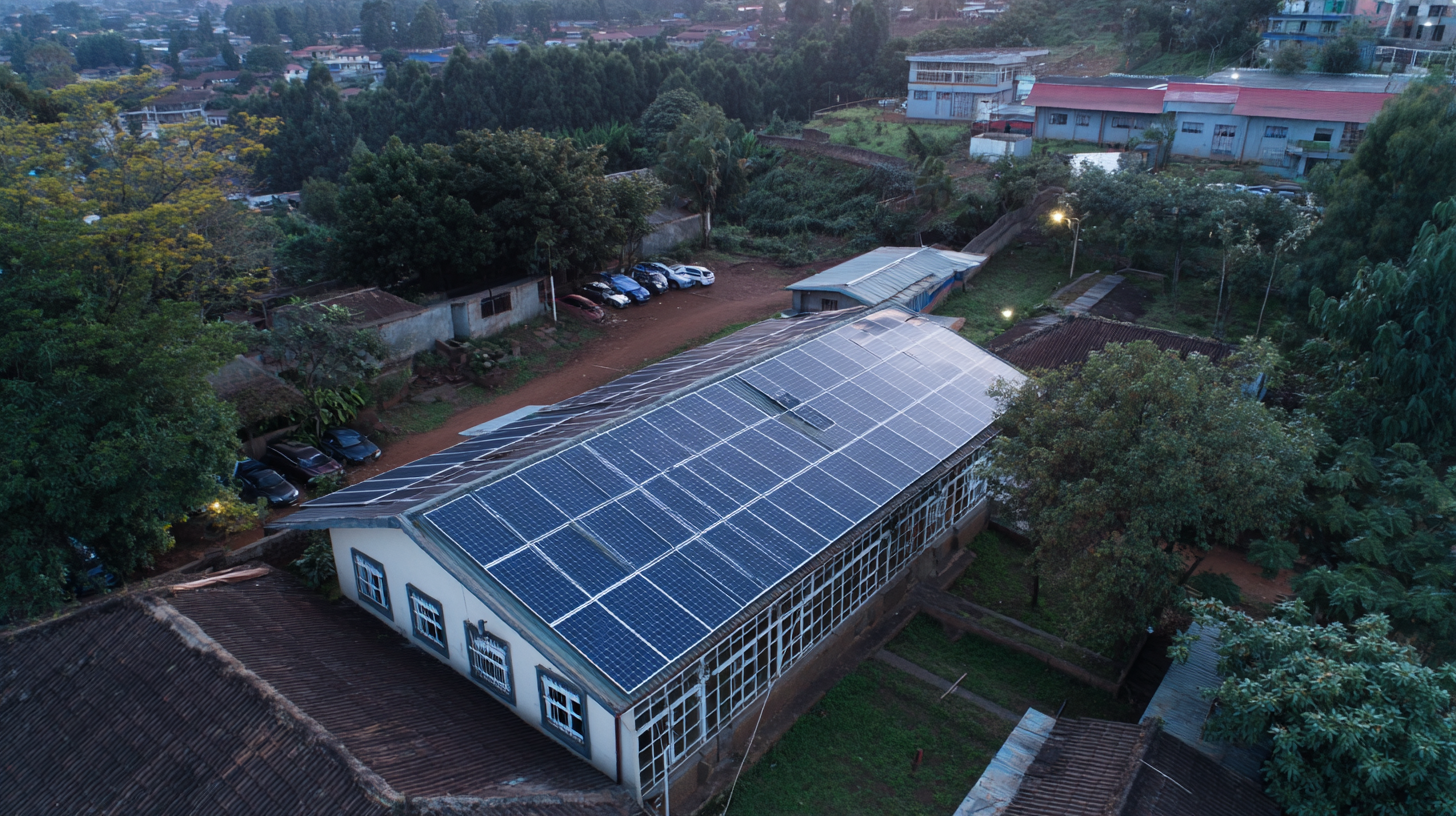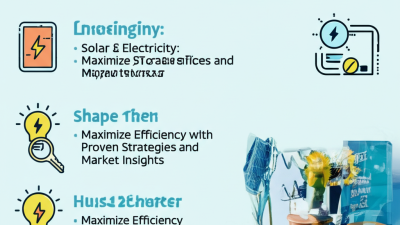What is the Future of Solar Energy in Sustainable Development
As the world grapples with the pressing challenges of climate change and diminishing natural resources, solar energy emerges as a pivotal player in sustainable development. According to the International Energy Agency (IEA), solar power has the potential to contribute up to 35% of global electricity generation by 2040, outpacing all other renewable sources. This surge is backed by a projected annual growth rate of over 20% in installed solar capacity, underscoring the technology's viability and cost-effectiveness. Furthermore, a report by the International Renewable Energy Agency (IRENA) indicates that the global solar workforce could exceed 24 million jobs by 2030, reflecting the sector's importance not only in energy transition but also in economic development and job creation. As nations strive to meet ambitious carbon reduction targets and build resilient economies, understanding the role of solar energy in sustainability is crucial for shaping a greener future for all.

The Role of Solar Energy in Achieving Sustainable Development Goals
Solar energy plays a crucial role in achieving the Sustainable Development Goals (SDGs) set by the United Nations. As countries strive to combat climate change and ensure access to clean energy, solar power emerges as a vital solution. By harnessing the sun's abundant energy, nations can reduce their dependency on fossil fuels, thereby decreasing greenhouse gas emissions and promoting a cleaner environment. This transition to renewable energy sources not only supports Goal 7 (Affordable and Clean Energy) but also contributes to Goal 13 (Climate Action), highlighting solar energy's dual impact on environmental sustainability and energy accessibility.
Moreover, solar energy initiatives can significantly enhance socio-economic development, particularly in underserved communities. By implementing solar projects, governments and organizations can provide electricity to remote areas, improving access to essential services such as education and healthcare. This aligns with Goal 4 (Quality Education) and Goal 3 (Good Health and Well-being), as reliable energy sources empower schools to operate efficiently and healthcare facilities to function effectively. Investing in solar energy not only fosters sustainable practices but also drives inclusive growth, enabling communities to thrive while remaining environmentally responsible.
Future of Solar Energy in Sustainable Development
This bar chart illustrates the anticipated contributions of solar energy to various Sustainable Development Goals (SDGs) by 2030. The data reflects the projected percentage of each SDG that solar energy can help achieve, emphasizing its role in promoting renewable energy, reducing poverty, improving health and education, and supporting sustainable cities and communities.
Innovations in Solar Technology Driving Future Sustainability
The future of solar energy in sustainable development is closely tied to remarkable innovations in solar technology that promise to transform how we harness and utilize this abundant resource. One significant advancement is the development of more efficient photovoltaic cells. Researchers are exploring materials like perovskite, which could significantly reduce costs while increasing energy conversion rates. These cutting-edge cells are not only lighter but also more flexible, allowing for new applications such as solar-integrated building materials and portable solar devices.
Another exciting trend is the emergence of solar energy storage solutions. Innovations in battery technology, such as lithium-silicon and solid-state batteries, are set to address the intermittent nature of solar power. Enhanced storage systems will enable households and businesses to store excess energy generated during sunny periods for use during cloudy days or at night. This capability will dramatically improve the reliability of solar energy, making it a more viable option for widespread adoption in various sectors. Through these innovations, solar technology is paving the way for a sustainable energy future, contributing significantly to a greener planet.
Economic Benefits of Solar Energy in Sustainable Development
The economic benefits of solar energy in sustainable development are increasingly evident as global investments in renewable energy reach new heights. According to the International Energy Agency (IEA), solar energy accounts for nearly 60% of the world's cumulative renewable energy investments, surpassing traditional fossil fuel sources. This trend not only indicates a growing shift towards cleaner energy but also highlights solar energy's potential to create jobs and stimulate economic growth. The IEA projects that by 2040, solar energy could create around 24 million jobs worldwide, transforming local economies and fostering energy independence.
Moreover, solar energy significantly reduces electricity costs for consumers and businesses alike. A report from Lazard indicates that the levelized cost of solar energy has dropped by 89% since 2009, making it one of the most cost-effective sources of electricity available today. As the cost of technology continues to decrease, more regions can adopt solar solutions, thereby enhancing energy access and equity. This transition not only benefits the environment but also boosts local economies, creating a sustainable cycle of growth that aligns with global development goals. With increasing governmental support and technological advancements, the future of solar energy in sustainable development appears promising and economically beneficial.
What is the Future of Solar Energy in Sustainable Development - Economic Benefits of Solar Energy in Sustainable Development
| Aspect | Description | Economic Impact |
|---|---|---|
| Job Creation | The solar energy sector is rapidly growing, leading to numerous job opportunities in manufacturing, installation, and maintenance. | Approximately 250,000 jobs created in the U.S. alone as of 2022. |
| Energy Independence | Utilizing solar energy can reduce reliance on imported fossil fuels and enhance energy security. | Potential savings of billions annually on energy imports. |
| Increased Property Values | Homes with solar energy systems tend to have higher property values. | Average increase of 4.1% in home value for solar-equipped homes. |
| Reduction in Energy Costs | Solar energy can lead to significant savings on electricity bills over time. | Savings of $20,000 to $40,000 over 20 years for average homeowners. |
| Environmental Benefits | Solar energy reduces greenhouse gas emissions and air pollution. | Potential reduction of 100 million metric tons of CO2 emissions annually. |
Challenges and Opportunities for Solar Energy Adoption Worldwide
The adoption of solar energy plays a crucial role in the quest for sustainable development globally, but it is not without its challenges. One of the primary obstacles is the initial cost of solar technology, which can be prohibitive for developing nations. Additionally, the intermittent nature of solar energy can lead to reliance on backup sources, contributing to the complexity of integrating solar systems into existing power grids. These technical and financial barriers must be addressed to unlock the full potential of solar energy and to make it accessible for all.

Despite these challenges, numerous opportunities are emerging in the solar energy sector. Technological advancements continue to reduce costs and increase efficiency, making solar energy more feasible for widespread adoption. Furthermore, international collaborations and investment in renewable energy can lead to innovative financing models that support solar infrastructure in low-income regions. As public awareness of climate change grows, there is a significant push for policies that prioritize renewable energy solutions, providing a conducive environment for solar energy initiatives. By leveraging these opportunities, we can advance the transition towards a sustainable energy future.
Integrating Solar Energy into Urban Planning for Sustainable Communities
Integrating solar energy into urban planning is crucial for developing sustainable communities. By prioritizing solar energy, cities can significantly reduce their carbon footprint and enhance energy security. Urban planners can design buildings with solar panels in mind, maximizing sunlight exposure and energy efficiency. Additionally, incorporating green spaces and tree cover can help mitigate the urban heat island effect, improving the overall climate of urban areas.
Tips for effective integration include ensuring that new developments comply with local solar energy regulations and incentives. Collaborating with architects and engineers early in the design process can result in innovative solutions that harness solar energy. Implementing community solar programs can also empower residents and businesses to share resources, making solar power accessible to a broader audience.
Another vital consideration is the installation of solar infrastructure in public spaces. Strategically placing solar panels on rooftops, parking lots, and bus shelters not only provides energy for local amenities but also promotes renewable energy use among residents. Educating the community about the benefits of solar energy and encouraging participation can foster a culture of sustainability that supports long-term urban resilience.

Related Posts
-

7 Compelling Reasons Why Solar Installation is Essential for Your Business Growth
-

How to Maximize Energy Efficiency with Power Solar Solutions for Global Buyers
-

Top Strategies for Implementing Solar Energy Solutions in Your Business
-

How to Choose the Right Solar Energy Provider for Your Home or Business
-

How to Harness Solar Electricity: Maximize Efficiency with Proven Strategies and Market Insights
-

How to Optimize Your Solar System Electricity Setup: A Step-by-Step Guide for Maximum Efficiency
